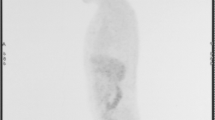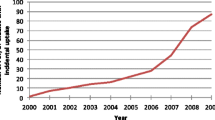Abstract
Positron emission tomography (PET) is a noninvasive functional imaging modality that can disclose the presence of a malignant disease. It has recently been reported that PET may be useful to detect primary colorectal cancer (CRC). We present the case of a 47-yr-old man with early colon cancer detected by 18F-fluorodeoxyglucose (FDG) PET. The patient consulted us because of a positive fecal occult blood test and focal FDG uptake in the pelvic cavity detected at a physical check-up. After the usual work up, he was diagnosed as having a sigmoid polyp, 16 mm in diameter. Subsequently, colonoscopic polypectomy was carried out. The surgical specimen was histologically diagnosed as a well-differentiated adenocarcinoma, invading the submucosal layer with lymphatic invasion. Therefore, the involved portion of the sigmoid colon was laparoscopically resected. The FDG PET carried out 1 yr after the operation, showed no abnormal FDG uptake. PET can noninvasively detect an early colon cancer as small as in our patient, as well as other cancers in the whole body. Therefore, we consider it suitable as a screening examination.
Similar content being viewed by others
References
Glaspy JA, Hawkins R, Hoh CK, Phelps ME. Use of positron emission tomography in oncology. Oncology 1993;7:41–50.
Arulampalam T, Costa D, Visvikis D, Boulos P, Taylor I, Ell P. The impact of FDG-PET on the management algorithm for recurrent colorectal cancer. Eur J Nucl Med 2001;28:1758–1765.
Johnson K, Bakhsh A, Young D, Martin TE Jr., Arnold M. Correlating computed tomography and positron emission tomography scan with operative findings in metastatic colorectal cancer. Dis Colon Rectum 2001;44:354–357.
Flanagan FL, Dehdashti F, Ogunbiyi OA, Kodner IJ, Siegel BA. Utility of FDG-PET for investigating unexplained plasma CEA elevation in patients with colorectal cancer. Ann Surg 1998;227:319–323.
Yasuda S, Fujii H, Nakahara T, et al. 18F-FDG PET detection of colonic adenomas. J Nucl Med 2001;42:989–992.
Okuno T, Fu KI, Sano Y, et al. Early colon cancers detected by FDG-pet: a report of two cases with immunohistochemical investigation. Hepatogastroenterology 2004;51:1323–1325.
Ogunbiyi OA, Flanagan FL, Dehdashti F, et al. Detection of recurrent and metastatic colorectal cancer: comparison of positron emission tomography and computed tomography. Ann Surg Oncol 1997;4:613–620.
Valk PE, Abella-Columna E, Haseman MK, et al. Whole body PET imaging with [18F]fluorodeoxyglucose in management of recurrent colorectal cancer. Arch Surg 1999;134:503–511.
Tutt AN, Plunkett TA, Barrington SF, Lesile MD. The role of positron emission tomography in the management of colorectal cancer. Colorectal Dis 2004;6:2–9.
Drenth JP, Nagengast FM, Oyen WJ. Evaluation of (pre-) malignant colonic abnormalities: endoscopic validation of FDG-PET findings. Eur J Nucl Med 2001;28:1766–1769.
Abdel-Nabi H, Doerr RJ, Lamonica DM, et al. Staging of primary colorectal carcinomas with fluorine-18 fluorodeoxyglucose whole-body PET: correlation with histopathologic and CT findings. Radiology 1998;206:755–760.
Kim S, Chung JK, Kim BT, et al. Relationship between gastrointestinal F-18-fluorodeoxyglucose accumulation and gastrointestinal symptoms in whole-body PET. Clin Positron Imaging 1999;2:273–279.
Tatlidil R, Jadvar H, Bading JR, Conti PS. Incidental colonic fluorodeoxyglucose uptake: correlation with colonoscopic and histopathologic findings. Radiology 2002;224:783–787.
Kayani I, Groves AM, Syed R, Bomanji J. Combined F-18 FDG positron emission tomography/computed tomography in the diagnosis of colonic polyps: the potential and limitations of the technique. Clin Nucl Med 2005;30:116–117.
Sakashita M, Aoyama N, Minami R, et al. Glutl expression in T1 and T2 stage colorectal carcinomas: its relationship to clinicopathological features. Eur J Cancer 2001;37:204–209.
Rigo P, Paulus P, Kaschten BJ, et al. Oncological applications of positron emission tomography with fluorine-18 fluorodeoxyglucose. Eur J Nucl Med 1996;23:1641–1674.
Chen YK, Kao CH, Liao AC, Shen YY, Su CT. Colorectal cancer screening in asymptomatic adults: the role of FDG PET scan. Anticancer Res 2003;23:4357–4361.
Kao CH, Kwan AS, Kwan JK, Chow MJ. The role of 18F-fluorodeoxyglucose positron emission tomography in cancer screening; a preliminary report. Oncol Rep 2001;8:1145–1148.
Author information
Authors and Affiliations
Corresponding author
Rights and permissions
About this article
Cite this article
Sakamoto, K., Takahashi, M., Yaginuma, Y. et al. Early colon cancer detected by 18F-FDG PET. Int J Gastrointest Canc 36, 95–98 (2005). https://doi.org/10.1385/IJGC:36:2:95
Issue Date:
DOI: https://doi.org/10.1385/IJGC:36:2:95




